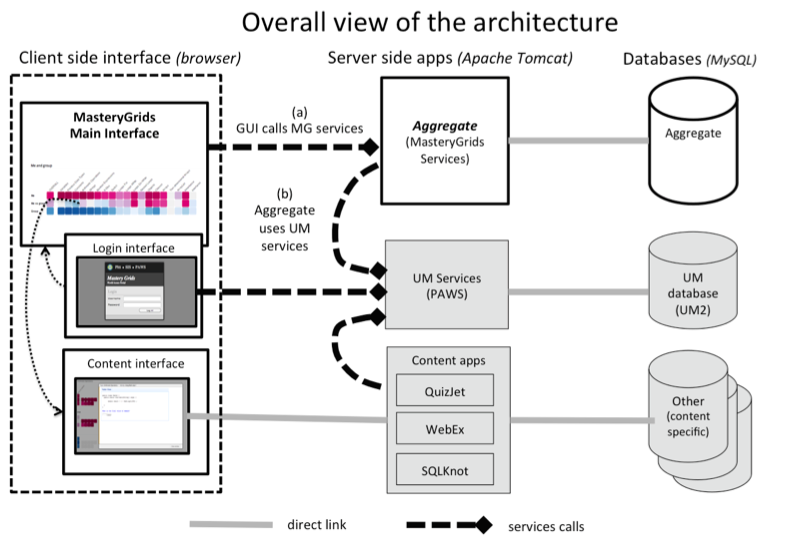Difference between revisions of "Adaptive Navigation Support and Open Social Learner Modeling for PAL"
(→Description) |
|||
| Line 29: | Line 29: | ||
[[Image:architecture_v1.png]] | [[Image:architecture_v1.png]] | ||
| + | |||
| + | === Authoring Tools === | ||
| + | |||
| + | The set of authoring tools developed for the project include tools for creating several kinds of smart learning content as well as tools to create adaptive courses that use this content | ||
| + | |||
| + | ==== Content Authoring ==== | ||
| + | This tool provides the interface for teachers to create and index annotated examples. [[ContentAuthoring|more]] | ||
| + | |||
| + | ==== Course Authoring ==== | ||
| + | This tool provides the interface for teachers to create courses for Mastery Grids. [[CourseAuthoring|more]] | ||
| + | |||
| + | ==== Group Authoring ==== | ||
| + | This tool provides the interface for teachers to define groups of students who can access the course. [[GroupAuthoring|more]] | ||
== Systems == | == Systems == | ||
| Line 40: | Line 53: | ||
[[Aggregate|More]] | [[Aggregate|More]] | ||
| − | |||
| − | == | + | == Links == |
| − | |||
| − | |||
| − | |||
| − | |||
| − | |||
| − | |||
| − | |||
| − | |||
| − | |||
Software sources and documentation is in GitHub. The Mastery Grids Interface, backend Aggregate and documentation can be found [https://github.com/PAWSLabUniversityOfPittsburgh/MasteryGrids here]. User model services can be found in [https://github.com/PAWSLabUniversityOfPittsburgh/AggregateUMServices here]. | Software sources and documentation is in GitHub. The Mastery Grids Interface, backend Aggregate and documentation can be found [https://github.com/PAWSLabUniversityOfPittsburgh/MasteryGrids here]. User model services can be found in [https://github.com/PAWSLabUniversityOfPittsburgh/AggregateUMServices here]. | ||
Revision as of 03:43, 12 March 2015
Contents
Description
The goal of this project is to leverage the power of open social learner modeling and adaptive navigation support in the context of the envisioned Personalized Assistant for Learning (PAL). The project is supported by the Distributed Learning Initiative contract W911QY13C0032.
Directions of work
The project focuses on both exploration and implementation of adaptive navigation support and open social learner modeling and pursues three directions of work
- Exploring open social learner modeling interface for diverse learning content
- Enhancing algorithms for personalized guidance using knowledge-based and social approaches
- Developing architectural solutions and authoring tools to support open social learner modeling
Open Social Learner Modeling Interfaces
Our latest implementation of Open Social Learner Modeling (OSLM) interface is MasteryGrids system. Mastery Grids is both, a innovative OSML interface and an adaptive E-learning platform with integrated functionalities enabling multi-facet social comparison, open user modeling, and multi-type learning materials support. It presents and compares user learning progress and knowledge level (mastery) by colored grids, tracks user activities and feedbacks dynamically and provides flexible user-centered navigation across different content levels (e.g. topic, question) and different content types (e.g. question, example) of learning materials.
The Architecture
The architecture supporting Mastery Grids fulfills a major objective, portability, which is the ability to be integrated to other systems with little set up and modification. The architecture is modular and includes different software components:
- frontend user-system interaction interface, the Mastery Grids Interface,
- backend Aggregate services communicating between the main interface and user modeling services,
- backend user modeling services, and
- backend content providing applications.
An overall architecture of the system can be sen in the next figure.
Authoring Tools
The set of authoring tools developed for the project include tools for creating several kinds of smart learning content as well as tools to create adaptive courses that use this content
Content Authoring
This tool provides the interface for teachers to create and index annotated examples. more
Course Authoring
This tool provides the interface for teachers to create courses for Mastery Grids. more
Group Authoring
This tool provides the interface for teachers to define groups of students who can access the course. more
Systems
Mastery Grids
MasteryGrids is an open social student modeling interface written in Javascript. The interface shows the student's progress levels in a series of topics and content items as long as provides navigation support and access to educational content.
Aggregate
Links
Software sources and documentation is in GitHub. The Mastery Grids Interface, backend Aggregate and documentation can be found here. User model services can be found in here.
A demo view of MasteryGrids can be accessed here
Publications
- Loboda, T., Guerra, J., Hosseini, R., and Brusilovsky, P. (2014) Mastery Grids: An Open Source Social Educational Progress Visualization. In: S. de Freitas, C. Rensing, P. J. Muñoz Merino and T. Ley (eds.) Proceedings of 9th European Conference on Technology Enhanced Learning (EC-TEL 2014), Graz, Austria, September 16-19, 2014 (Best paper award).

